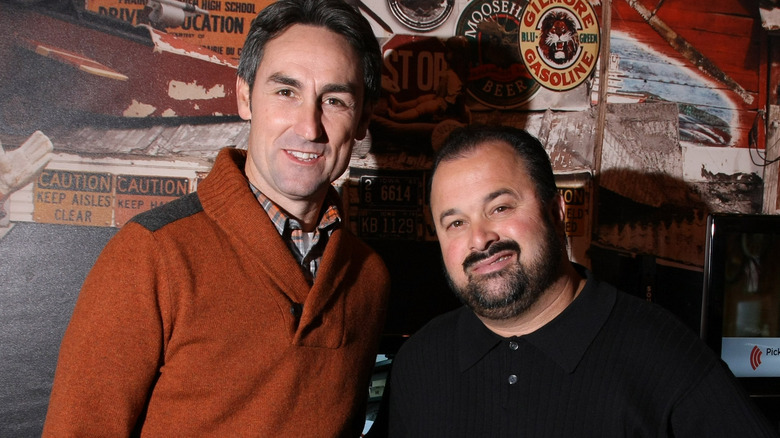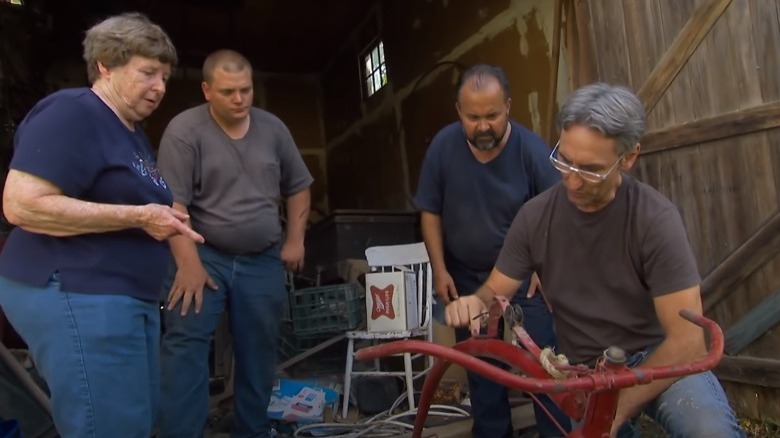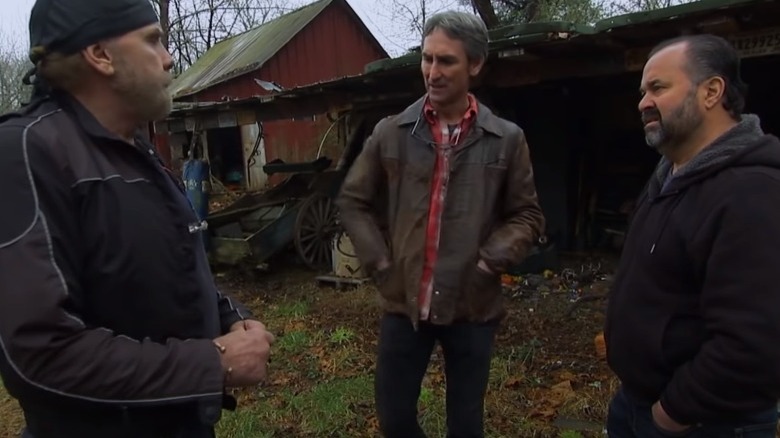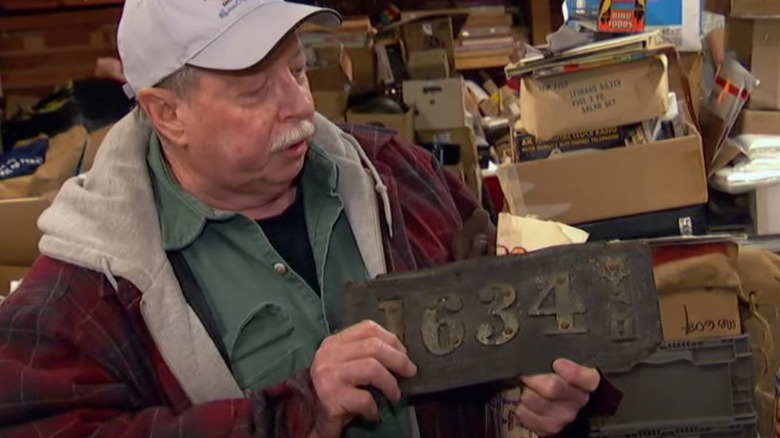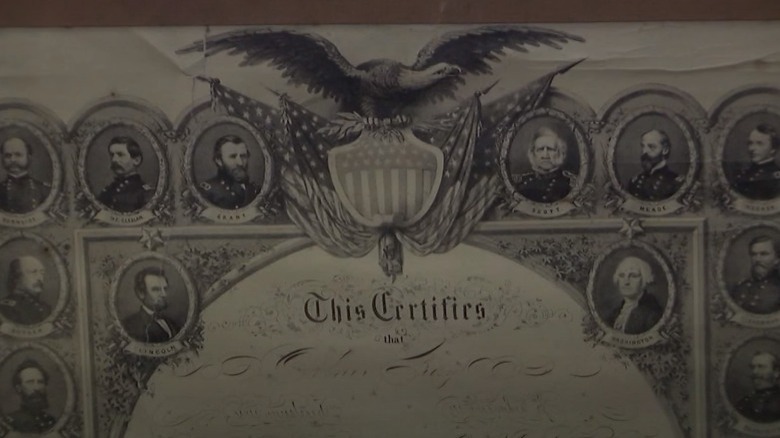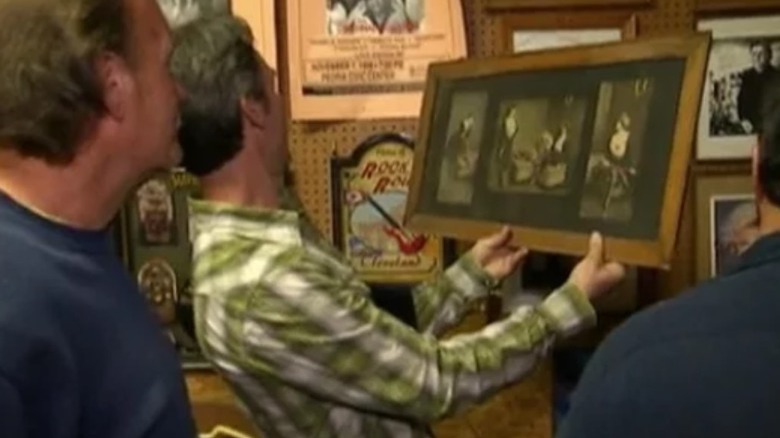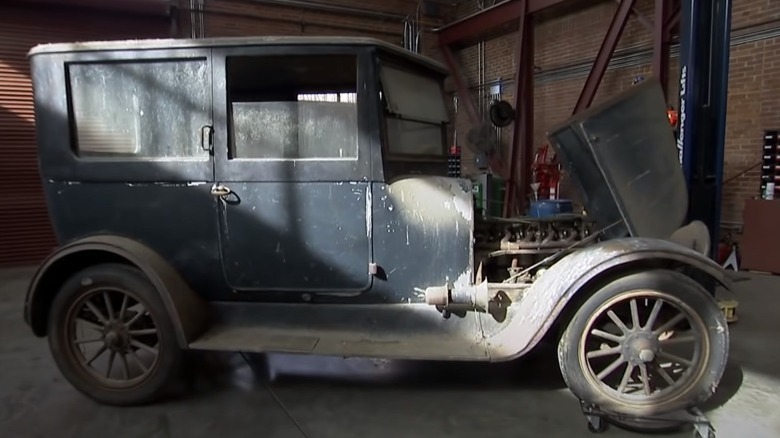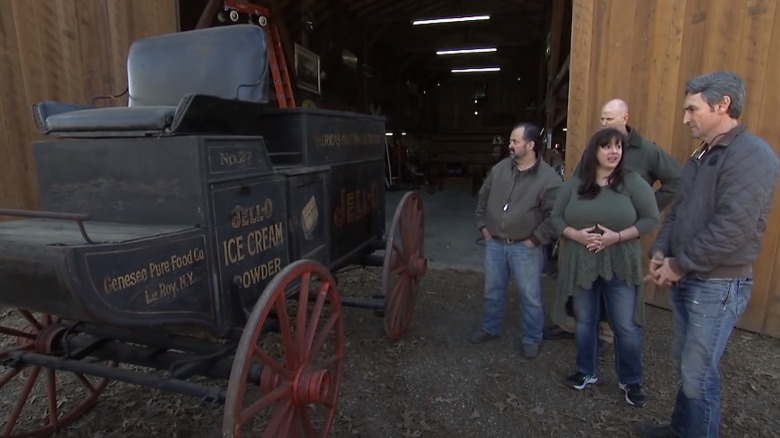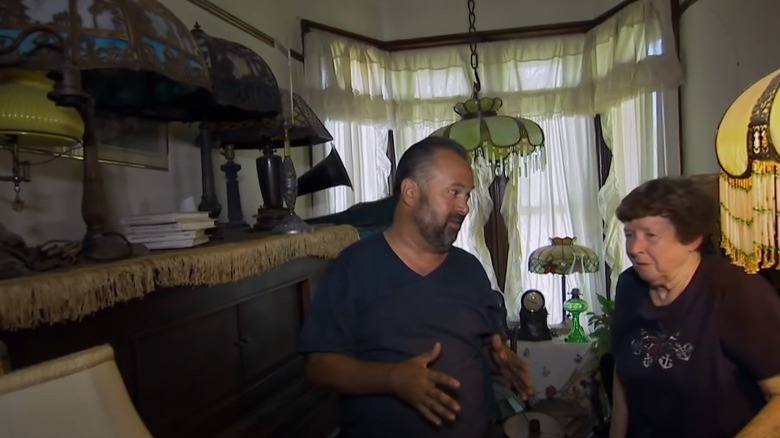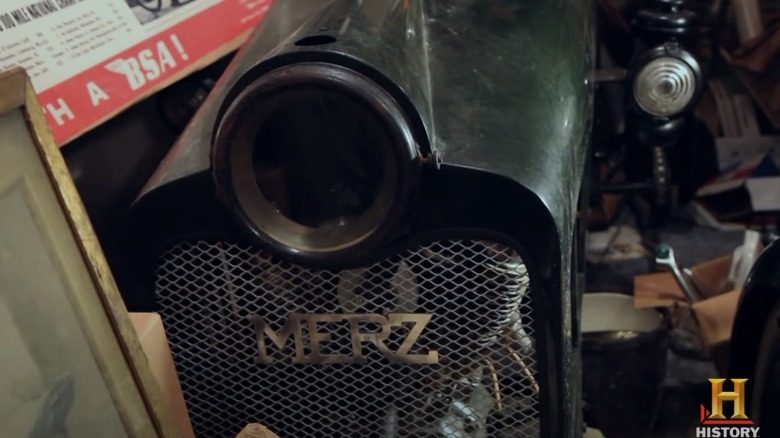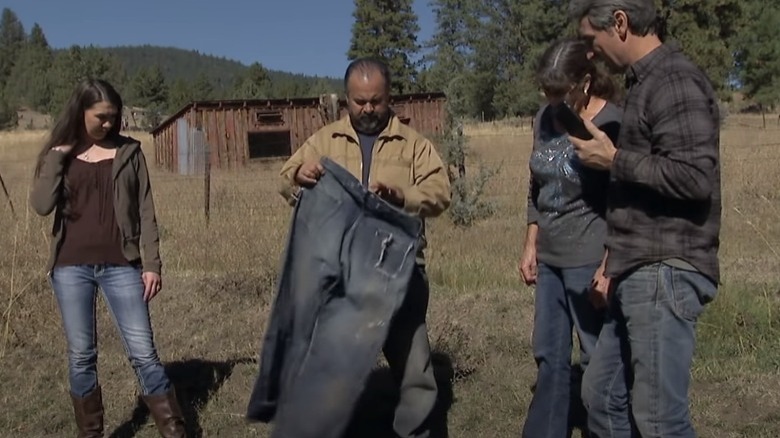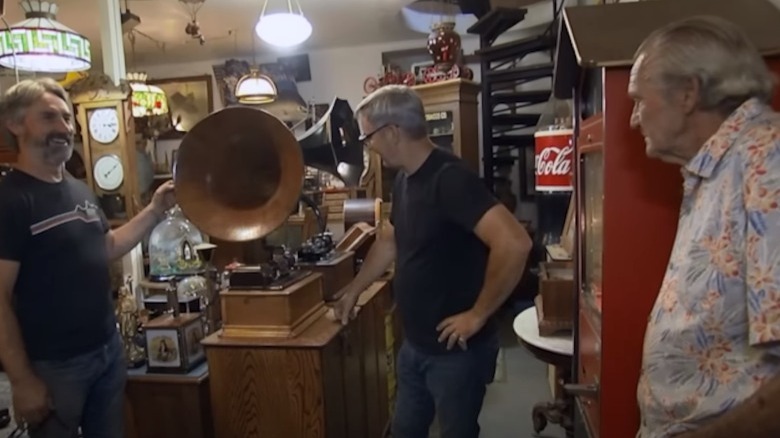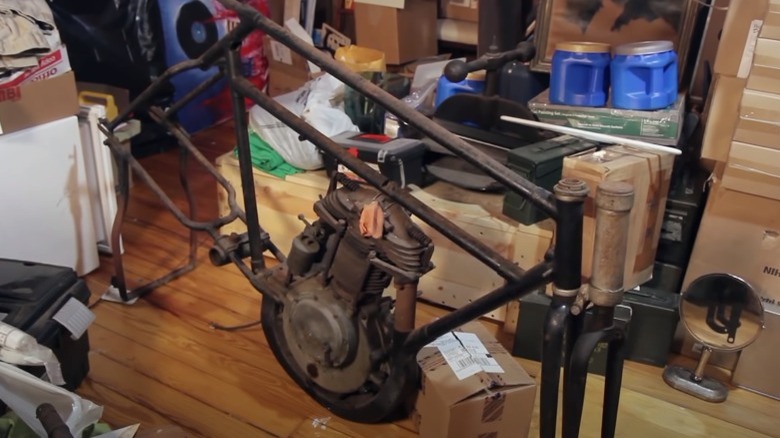The Oldest Finds On American Pickers
It's no secret that people love their gadgets, and when they can upgrade to the next model, the bigger, better, faster, version of their tech of choice? Then, it's a good day to be alive. There's something about a brand new phone, a computer with a fresh new desktop ... a keyboard without crumbs in it. But, there's also something fascinating about old stuff, too.
And for that, it has to be not just old ... but really old. Fans of "American Pickers" know that Mike Wolfe and Frank Fritz are all about the old stuff, and after watching just one episode, it's clear that they're not going to let a little dust, dirt, or grime get in the way of uncovering something incredible. Whether it's signs, oil cans, motorcycles, or old toys, they're there for it — and so are we.
What is it about these old things that's so cool? It's more than just some archaic technology, it's a connection to both the past and our past. Sometimes it's tough to imagine these old finds, shiny and brand new on the shelf of the general store. But that's the thing: So much of what we surround ourselves with today is simply disposable. It's not going to be around in 10 years, much less a hundred — so let's look at some of the oldest things ever found on "American Pickers," and see what we can learn from them.
A Columbia high-wheel bicycle
In the 18th season of "American Pickers," Mike Wolfe and Frank Fritz swing open the doors of an old carriage house, only to see a bike collector's Holy Grail hanging on the wall. Wolfe takes the bike down and starts to go over it, explaining that the incredibly dangerous-looking high-wheeled bike was made by Columbia Bicycle and The Pope Manufacturing Co. well over a century ago. (Meanwhile, the owner confirmed that yes, they'd found out the hard way that it was just as hard to ride as it looked.)
According to the Connecticut Historical Society, the bike was wildly revolutionary. The "Pope" of the Pope Manufacturing Co. was the Civil War veteran Colonel Albert Pope, and it was in 1878 that he introduced the line of bikes that the pickers found. It was a huge deal for a few reasons: In addition to his commitment to mass producing them — which allowed them to become what the Smithsonian calls the first widely available mode of personalized, motorized transport — they featured a design that, although tricky to ride, was a huge step forward from the earlier bikes.
The design of the bike Wolfe and Fritz found was called an "ordinary," and it was just over a decade later that Pope introduced his so-called "safety" model, which is the sort of bike we know today. While bikes like the carriage house find weren't made for long, they were an important step in shaping our modern bicycles.
An antique sword
The concept of "American Pickers" might be deceptively straightforward, but that hasn't stopped the show from having some seriously admirable longevity. And that's a good thing, too — because according to History, it was only in Season 19 that Mike Wolfe and Frank Fritz found what would be their oldest pick: an antique sword.
The episode saw the pickers visiting a military veteran named Zipp, who not only had a ton of military memorabilia and vehicles but some that had even been used in films like "Forrest Gump." That made it not only a paradise for anyone who loves their military history but film history, too.
It wasn't the vehicles that ended up being the star of the show, though, that was the sword. According to Zipp, the imperfections in the blade were from use in battle, and while there was little in the way of provenance or specific history that came along with the blade, the ornate design suggested that it had been carried by an officer. It's Wolfe who becomes enamored with the 1850s-era blade and agrees to take it home for the cool price of $800.
Leather license plate
Collecting license plates is serious business — there's even an Automobile License Plate Collectors Association, and they say it's a lot more complicated than it seems at a glance. (Some people specifically collect plates from now-defunct countries, which is pretty cool!) License plates are a fairly new invention, and it was only in the 1920s that most U.S. states were making and assigning their own metal plates. It was something Massachusetts had been doing since 1903, and before metal plates, drivers were expected to make their own plate.
In Season 13, "American Pickers," Mike Wolfe and Frank Fritz visited a collector with rare automobile memorabilia, including one of these early, turn-of-the-century license plates. Made from leather, it's perhaps not surprising that they didn't often survive. The one handed to Wolfe was the only known leather license plate issued to the Oldsmobile company — who put it on cars they were driving and testing — and it was dated to 1908.
Did Wolfe buy it? Absolutely: Noting that the number of people who would be interested in the one-of-a-kind find included a variety of collectors, he made a deal with his first offer of $1,000. According to Autoweek, they made a $200 profit when they sold it to the R.E. Olds Museum in Lansing, Michigan — which just happens to have the car it was attached to more than a century ago.
Civil War memorabilia
Over the course of the well-into-double-digits seasons of "American Pickers," they've found their fair share of Civil War-era items, including some that were donated to The Gettysburg Museum of History.
Mike Wolfe and Frank Fritz teamed up with the museum in connection with the History Channel's Civil War Week, and they found some incredible stuff — like a Confederate Dog River saber, which was loaned to the museum. They also found a rare Union frock coat: Because wool is a magnet for damage, it's unusual for them to survive as long as this one did — and it's even rarer to find one in excellent condition.
Speaking of rare, there was another rare — and incredibly personal — Civil War find in Season 14. That's when Wolfe came across some Civil War discharge — or "mustering out" papers — that had been framed and preserved. Dated to 1864, the papers listed all the battles the soldier had fought in, and according to the owner, he had lived not in her house, but next door. Just how they had made it into her collection wasn't clear, but it was a fortunate find that ultimately preserved a deeply personal piece of U.S. history.
Risqué Victoria-era pictures
While we tend to think of our Victoria-era ancestors as incredibly repressed, almost painfully proper sort of people, it's worth remembering that under all those frock coats and layers of fabric, they were as human as anyone else. Mike Wolfe and Frank Fritz found that out in an amusingly graphic way, way back in Season 2.
Looper calls their find of Victoria-era erotica one of the best picks of the season, and it's easy to see why. Although the photos are incredibly tame by today's standards — you're likely to see something more risqué on prime-time television — they're a brilliant look at what might have decorated the walls of a gentleman's private sanctuary. Ladies show their legs, and also show that they're not to be trifled with: They're also holding fencing swords.
Interestingly — and in the interest of historical accuracy — it's worth noting that the images were pretty tame by Victorian standards, too. As HuffPost points out, there was plenty of NSFW art out there, including pieces done by famous artists like Mihaly Zichy — not to mention literature like the almost unthinkably raunchy "My Secret Life: An Erotic Diary of Victorian London" (via GoodReads). Knowing just how X-rated Victorian art and literature could get is important in being able to appreciate the pickers' find even more: That piece can be hung on a wall and still be considered perfectly respectable.
1919 Franklin car
It's easy to hop in our 21st-century cars and take things like push-button starting and heated seats for granted, and it's the perspective that old cars bring that just makes them so gosh darn cool. The industry has come a long way, and in Season 17, Mike Wolf and Frank Fritz secured what was then a century-old car: a rare 1919 Franklin.
They were in Chattanooga, Tennessee, after pulling the wildly original car out of a barn and handing it over to longtime friend Corky Coker for a restoration. While there's definitely no cruise control or even cup holders, it was not just in shockingly good condition, but it started right up, too. The interior looked as though it would be like-new with a quick spit-and-polish, but when all was said and done, the car was less of a big score and more of an important lesson.
The pickers paid $6,000 for it, and the cost of the restoration work added up fast. Coker warned them that it wouldn't be long before they invested the car's entire value into it, and that was somewhere between $10,000 and $12,000. Fortunately, Coker had someone who would buy it for $8,500, so it wasn't a complete loss — but it does bring up the question: What did it originally cost? ConceptCarz says that in 1919, Franklin cars sold for between $2,400 and $3,400, depending on the model. Adjusted for inflation, that's the equivalent of $39,050 and $55,300. Luxury!
A Jell-O wagon
At least once an episode, someone on "American Pickers" will remind viewers that what they're really looking for are the treasures hidden in the overgrown yards, inside the old buildings, under the dirt and grime, and past the cobwebs. That, said Mike Wolfe, is why he originally walked right past the old, horse-drawn wagon with "JELL-O" painted on the side.
In 1897, Pearle Wait developed the fruity dessert when he was making what the Jell-O museum describes as "a cough remedy and laxative tea." It didn't take off when he tried to sell it, but after he sold the patent — for $450 — the new manufacturer kicked off a massive marketing campaign that set Jell-O on the way to widespread popularity. That was in 1904 — the same year, says NPR, that the wagon was built.
Wolfe offered $6,500 first, saying that he had a sneaking suspicion that it was going to take a while for him to find the "very specialized buyer" that would be interested in the piece. The seller took the deal, and it didn't take long to find the buyer after all. And the wagon? It went back home. The birthplace of Jell-O is a little, unassuming town in Western New York called LeRoy — it's also where the Jell-O museum is. The wagon was ultimately bought by the Buffalo Transportation Pierce-Arrow Museum in Buffalo, just a stone's throw (or so) from where it had been built 113 years prior.
Turn of the century stained glass lamps
Frank Fritz described it as "lamp-o-rama!" when he walked into one room of a home they'd been called to for Season 18.
There were two in particular that caught his eye first, and while he didn't give precise dates immediately, he estimated they were anywhere from 70 to 90 years old. That put them comfortably around the turn of the century, which squares with the history of the craft as shared by The Stained Leaded Glass Company. They say that English immigrants settled in the States in the late 1800s and established the first stained glass studios. From there, artists — including Tiffany — started developing a uniquely American version of the art form, built around the new opalescent glass.
Fritz lamented the scarcity of lamps, noting that it was likely the owner had purchased these decades before. And — since scarcity drives the price — it's not entirely surprising that he offered a whopping $600 for one, and $400 for one with a broken glass panel. And that's nothing — the next lamp he asked about was quickly valued by the owner at around $1,000. Sounds pricey? It was a Handel, and according to Handel Lamps, they can sell for up to around $20,000 each. They estimate that around 20% of all Handel lamps are worth upwards of $5,000.
Merz cycle car
While 21st-century cars are definitely faster and more comfortable than their olde-timey ancestors, they're also kind of boring. Creativity goes into the outside, and it's one 1914 car picked by Frank Fritz that really showcases just how funky early transportation could get.
As they explain on "American Pickers," early cars cost a fortune. While not everyone could afford one, everyone wanted one — and since necessity is the mother of invention, that's where the cycle cars came in. These motorcycle-car crosses had the ability to carry both a driver and passenger, but were more affordable as they ran on the same engines used in more widely available motorcycles.
Finding flaws didn't take going over the car with a fine-toothed comb: The hood ornament was missing, the paint had been redone, and the headlight was wrong, but given the fact that it was a century-old car? It was still a wildly impressive find. The pickers remarked that it should be in a museum, and that's exactly where it ended up. The cycle car is now on display at the National Motorcycle Museum, where it's one of several cycle cars. It still, however, is still known as only one of two Merz cycle cars still in existence.
Vintage Levis
While this find wasn't necessarily as old as some of the others, it's got two things going for it: Not only is "nearly a century" pretty respectable, but it's also impressive because when denim jeans come to mind, it's because they're durable, take a beating, and definitely aren't expected to last a century — but century-old jeans are precisely what Mike Wolfe and Frank Fritz found while they were on a pick in Oregon.
They walked into a building and found the jeans — once worn by workers on the property — "just hanging there, like they'd never left," said Wolfe. Unfortunately, condition is everything — and as might be expected, these jeans were in pretty rough shape. The oldest, 1930s-era jeans would command around $2,500 in great condition, but with tears and missing pockets, the pickers' expert estimates they would still bring in around $600 to $800 retail.
That said, don't throw away those old Levis. In 2017, a pair of ultra-rare, 1890s-era jeans — which had never been worn — went to auction, with Inside Edition experts guessing they were going to sell for up to $80,000. The following year, the Associated Press reported that an 1893 pair of Levis were bought by a collector in Asia, who handed over around $100,000 for the denim.
Phonographs and Thomas Edison's record
It was Season 23 when Mike Wolfe walked into Wayne's Ranch and found a room full of old phonographs. Not only were there a lot of them, but they were in immaculate condition, and played records as clearly as they did the day they were made.
And that was a long, long time ago. According to the Smithsonian, Edison's first successful phonographs were developed in 1877, and they were the first machines capable of recording sound and playing it back. Surprisingly, these old phonographs are on the affordable side — unlike turn-of-the-century lamps where a collector might have to fork over tens of thousands of dollars, one of the first machines Wolfe looked at retailed for about $6,500. That's still pricey, of course, but it's also a piece of audio history — and Wolfe was shocked to learn that some of the other phonographs retailed for only a few hundred dollars.
In addition to the phonographs, fan favorite Wayne also had one of the records that Edison had recorded himself. The earliest of his records were from the first days of testing his phonographs, and some of the oldest recordings include Edison reciting "Mary Had a Little Lamb." And that wasn't all: Some of the phonograph horns had been hand-painted by artists who made their living traveling to stores and painting the intricate designs on the phonographs. While dates weren't given, the advent of sound-reproducing machines is considered to be between 1878 and 1898.
1910 Royal Pioneer frame
For one episode of Season Nine, Mike Wolfe and Frank Fritz headed into an area where neither expected to find anything good. And then, they walked inside. At a glance, it certainly didn't look like much — but what separates "all right" pickers from exceptional pickers, and that's the ability to spot the diamonds in the rough. While it looked like just a few pieces of metal stuck haphazardly together was an old frame from a 1910 Royal Pioneer motorcycle.
It wasn't just old, it was rare, too. One of just four in existence, that rarity didn't keep Fritz from being shocked when Wolfe made a first offer at $35,000. The owner was having none of that and countered with an even more shocking $60,000. The two prices were way too far apart for a deal to be made ... until, that is, Wolfe agreed to spend $55,000.
So what, exactly, made this so special? That takes a bit of a look at the history of Royal Pioneer, and according to Hemmings, that history is a tragically short one. The company formed in 1901, and by 1909, they were ready to release a motorcycle that was slated to be nothing short of revolutionary. It was lightweight, with a frame that doubled as an exhaust pipe, and a never-before-seen suspension. The bike went into production in 1910, and it ended up being the only production year as the company went out of business after suffering a devastating fire.
